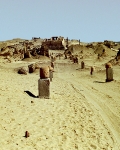Karanis
Archaeology »
Archaeological Monuments » Karanis
Karanis - Egypt
Karanis is located in Cairo.
Karanis monument was established on 1800.
Primary threats to Karanis :
The town was occupied for a total period of around seven centuries and saw many changes after the end of dynastic rule in Egypt.
Historical facts of Karanis :
- Karanis, also known as Kom Aushim, is an ancient archaeological site located in the Fayoum Oasis, southwest of Cairo, Egypt. It is situated in the Faiyum Governorate, approximately 80 kilometers southwest of the capital city. Karanis holds great historical significance, as it was once a thriving Greco-Roman settlement that flourished during the Hellenistic and Roman periods.
- The monument of Karanis was established around 1800, and it served as a center for agricultural activities and trade in the region. The settlement was strategically positioned near Lake Moeris, an important source of water for irrigation and agriculture. The fertile land surrounding Karanis allowed for the cultivation of crops such as grains, fruits, and vegetables, making it an economically prosperous area.
- Karanis was founded by the Ptolemaic dynasty, which ruled Egypt after the death of Alexander the Great in 323 BCE. It was during this period that Greek culture and influence spread throughout Egypt, resulting in the fusion of Greek and Egyptian traditions. The city grew rapidly under Ptolemaic rule, attracting Greek settlers and becoming an important center of commerce and administration.
- During the Roman period, which began in 30 BCE with the annexation of Egypt by Octavian (later known as Augustus), Karanis continued to thrive. The Romans expanded the city's infrastructure, constructing new buildings, roads, and aqueducts. The Roman influence can be seen in the architectural style of the structures found at the site, including temples, houses, and public buildings.
- One of the most remarkable features of Karanis is its well-preserved residential area. The houses of Karanis were typically built around a central courtyard, with multiple rooms arranged in a square or rectangular layout. These houses provide valuable insights into the daily lives of the inhabitants, revealing their social structure, domestic activities, and religious practices.
- The archaeological excavations at Karanis have unearthed a wealth of artifacts and historical evidence. The remains of pottery, glassware, jewelry, coins, and agricultural tools have been discovered, shedding light on the material culture and economic activities of the inhabitants. In addition, numerous papyri have been found, offering valuable insights into the administrative, legal, and personal affairs of the people of Karanis.
- The papyri found at Karanis provide a unique glimpse into the lives of ordinary people, revealing details about their occupations, marriages, inheritances, and religious beliefs. They also offer valuable information about the multicultural nature of the city, with Greek, Egyptian, and Jewish communities coexisting and interacting within its boundaries.
- The decline of Karanis began in the 4th century CE, with the rise of Christianity and the gradual shift of power to Alexandria and other major cities in Egypt. The city was eventually abandoned, and its remains were covered by layers of sand and debris, preserving its ancient structures for future excavation and study.
- Today, Karanis is an important archaeological site that attracts scholars, researchers, and tourists from around the world. The ongoing excavations and studies conducted at the site continue to reveal new insights into the history and culture of this once-thriving Greco-Roman city. Karanis stands as a testament to the enduring legacy of the ancient civilizations that shaped Egypt and the Mediterranean world.

